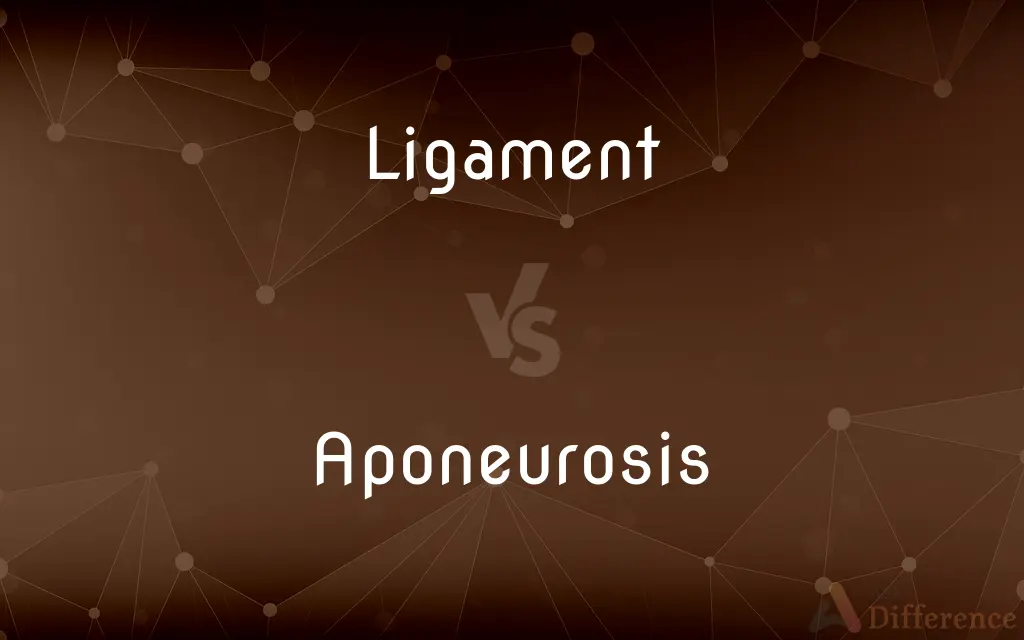Ligament vs. Aponeurosis — What's the Difference?
By Maham Liaqat & Fiza Rafique — Updated on April 6, 2024
Ligaments are fibrous tissues connecting bones at joints, aiding in stability, while aponeuroses are flattened tendons connecting muscles to bones or other muscles, distributing force.

Difference Between Ligament and Aponeurosis
Table of Contents
ADVERTISEMENT
Key Differences
Ligaments are specialized connective tissues that connect bones to bones, providing joint stability and guiding motion. They are composed primarily of long, stringy collagen fibers that give them great strength and a little bit of elasticity. This composition allows ligaments to withstand tensile forces while limiting excessive movement that could lead to joint injury. Whereas aponeuroses are broad, flat sheets of connective tissue that act similarly to tendons in connecting muscles to bones or other muscles but differ in their structure and function. They have a wide surface area that is ideal for attaching muscles with a broad force distribution requirement, such as in the abdominal wall or the palm of the hand.
Ligaments are crucial in maintaining joint stability and are typically found surrounding joints where they provide mechanical support. They are less elastic than tendons and muscles, which allows them to restrict the movement of joints to prevent dislocation or other forms of joint instability. On the other hand, aponeuroses are designed to spread out muscular force over a wide area, making them essential for muscle attachment in regions of the body where space is limited or where the force needs to be distributed over a larger area for effective action.
Due to their function and structure, ligaments are more likely to be involved in injuries related to joint stress, such as sprains, where the ligament is stretched or torn. Recovery from such injuries can be slow due to the poor blood supply to ligaments. In contrast, injuries to aponeuroses are less common but can occur in the form of tears or inflammation, often due to overuse or acute trauma. The recovery process may vary depending on the extent of the injury and the specific aponeurosis involved.
The healing process for ligaments can be prolonged, which restricts the flow of nutrients and oxygen necessary for repair. This characteristic makes treatment and recovery from ligament injuries a slow and sometimes challenging process. Aponeuroses, cover a broader area and may experience different healing dynamics due to their distinct role and structure, potentially influencing the approach to treatment and rehabilitation.
In terms of anatomical presence, ligaments are predominantly associated with joints and are essential for joint stability and function. Each ligament has a specific role depending on its location and the movements it supports or restricts. Aponeuroses, although less mentioned in common discourse, play a vital role in muscle function and biomechanics, especially in large or flat muscle groups where they act as a critical interface for muscular force transmission.
ADVERTISEMENT
Comparison Chart
Definition
Fibrous tissue connecting bones at joints
Flat sheet of fibrous tissue connecting muscle to bone or other muscles
Function
Provides stability and limits excessive movement at joints
Distributes muscular force over a wide area
Composition
Composed mainly of collagen fibers
Composed of dense fibrous connective tissue
Location
Surrounding joints
At sites of muscle attachment, often where space is limited
Injury and Healing
Prone to sprains and heals slowly due to poor blood supply
Less prone to injury but can suffer tears; healing varies by location and severity
Compare with Definitions
Ligament
Serves primarily to provide stability and prevent excessive movement.
Ligaments in the ankle prevent it from twisting too far sideways.
Aponeurosis
Consists of layers of dense, fibrous connective tissue.
The aponeurosis in the palm spreads out the force from the forearm muscles.
Ligament
Heals slowly due to limited blood supply, making recovery challenging.
Ligament injuries often require physical therapy to fully heal.
Aponeurosis
The healing process can vary, often depending on the extent of use and injury.
Rehabilitation from aponeurosis injury may include rest and gradual exercise.
Ligament
Composed mostly of collagen, giving them great tensile strength.
The collagen fibers in ligaments are aligned in parallel bundles.
Aponeurosis
Functions to distribute muscle force over a wide area.
The abdominal aponeurosis helps distribute the force during core exercises.
Ligament
Can be damaged through stretching or tearing, leading to sprains.
A torn ligament in the shoulder can significantly limit arm movement.
Aponeurosis
A broad, flat tendon that attaches muscles to bones or other muscles.
The galea aponeurotica connects the frontal and occipital muscles.
Ligament
A band of tough, fibrous tissue connecting bones at a joint.
The anterior cruciate ligament (ACL) is critical for knee stability.
Aponeurosis
Less commonly injured than ligaments but can suffer from tears.
Overuse of the forearm can lead to aponeurosis inflammation.
Ligament
A ligament is the fibrous connective tissue that connects bones to other bones. It is also known as articular ligament, articular larua, fibrous ligament, or true ligament.
Aponeurosis
An aponeurosis (; plural: aponeuroses) is a type or a variant of the deep fascia, in the form of a sheet of pearly-white fibrous tissue that attaches sheet-like muscles needing a wide area of attachment. Their primary function is to join muscles and the body parts they act upon, whether it be bone or other muscles.
Ligament
(Anatomy) A sheet or band of tough, fibrous tissue connecting bones or cartilages at a joint or supporting an organ.
Aponeurosis
A sheetlike fibrous membrane, resembling a flattened tendon, that serves as a fascia to bind muscles together or as a means of connecting muscle to bone.
Ligament
A unifying or connecting tie or bond.
Aponeurosis
(anatomy) A flattened pearly white fibrous membrane taking the place of a tendon that binds together and forms the terminations and attachments of muscles or connects them to other body parts like skin or bone.
Ligament
(anatomy) A band of strong tissue that connects bones to other bones.
Aponeurosis
Any one of the thicker and denser of the deep fasciæ which cover, invest, and the terminations and attachments of, many muscles. They often differ from tendons only in being flat and thin. See Fascia.
Ligament
(figurative) That which binds or acts as a ligament.
Aponeurosis
Any of the deeper and thicker fascia that attach muscles to bones; resemble flattened tendons
Ligament
Anything that ties or unites one thing or part to another; a bandage; a bond.
Interwoven is the love of liberty with every ligament of your hearts.
Ligament
A tough band or plate of dense, fibrous, connective tissue or fibrocartilage serving to unite bones or form joints.
Ligament
A sheet or band of tough fibrous tissue connecting bones or cartilages or supporting muscles or organs
Ligament
Any connection or unifying bond
Common Curiosities
Why do ligament injuries heal slowly?
Ligament injuries heal slowly due to their poor blood supply.
Where are aponeuroses typically found?
Aponeuroses are found where muscles attach to bones in areas requiring a wide force distribution, like the abdominal wall.
What is the primary function of an aponeurosis?
An aponeurosis distributes muscular force over a wide area.
Are ligaments elastic?
Ligaments have a little elasticity to allow joint movement but are mainly designed to limit excessive movement.
What is the difference between a tendon and an aponeurosis?
Both connect muscle to bone, but tendons are cord-like, whereas aponeuroses are broad and flat.
Can you strengthen ligaments?
Through exercise and proper nutrition, ligaments can become stronger and more flexible, but they primarily adapt by becoming more efficient at their function.
What is a common injury for aponeuroses?
Common injuries include tears or strain due to overuse or sudden, acute trauma.
How do ligaments contribute to joint stability?
By mechanically limiting the range of motion, ligaments prevent dislocations and support joint stability.
What connects bones to bones?
Ligaments connect bones to bones, providing stability at joints.
Can aponeuroses get injured?
Yes, aponeuroses can suffer from tears or inflammation, though less commonly than ligaments.
What materials compose ligaments and aponeuroses?
Both are made of fibrous connective tissue, with ligaments being rich in collagen fibers.
How can you prevent ligament injuries?
Strengthening surrounding muscles, improving flexibility, and practicing proper technique in sports and activities can reduce the risk.
What makes aponeuroses different from other connective tissues?
Their broad, flat structure designed for efficient force distribution across muscles distinguishes them.
Do aponeuroses have a role in muscle contraction?
While they don't contract, aponeuroses play a critical role in transmitting the force generated by muscle contraction.
Is surgery often required for ligament or aponeurosis injuries?
Surgery may be necessary for severe cases, especially when there's a complete tear, but many injuries can be managed with conservative treatment methods.
Share Your Discovery

Previous Comparison
Vomiting vs. Regurgitation
Next Comparison
Anthophyta vs. ConiferophytaAuthor Spotlight
Written by
Maham LiaqatCo-written by
Fiza RafiqueFiza Rafique is a skilled content writer at AskDifference.com, where she meticulously refines and enhances written pieces. Drawing from her vast editorial expertise, Fiza ensures clarity, accuracy, and precision in every article. Passionate about language, she continually seeks to elevate the quality of content for readers worldwide.














































